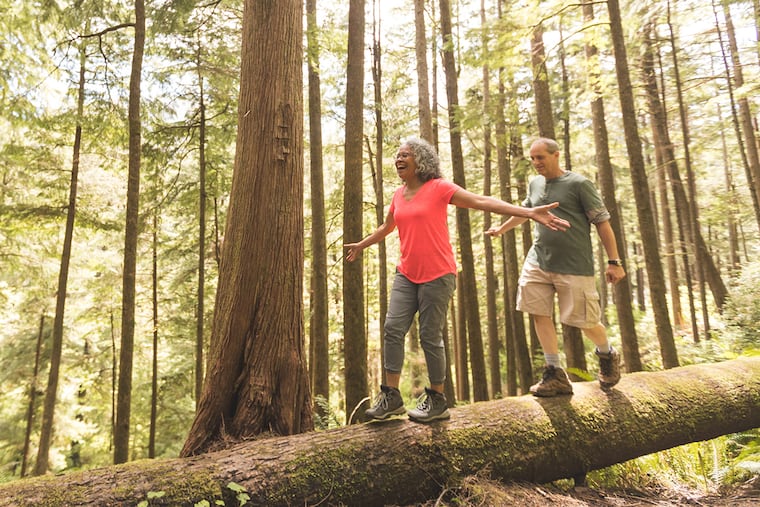Functional fitness: 3 exercises to improve balance
Balance is about finding your center of gravity and figuring out the best position of harmony while standing on your feet.

Whether you are an athlete with a goal of becoming more powerful or an older adult who wants to become more independent, everyone can reap the benefits of improving balance.
As we age, factors such as weight gain, reduced muscle mass, and diminished bone density can leave the body weak, unbalanced, low on energy, and at risk for injuries. Balance is about finding your center of gravity and figuring out the best position of harmony while standing on your feet. The whole body is involved in this daily effort, including the eyes, ears and muscles, but mostly our feet.
Our month-long functional fitness series is designed to help you begin a journey toward better health. The intent is to reduce physical insecurity through exercises that allow you to increase your personal fitness level without a lot of space or equipment. Balance exercises can reduce the risk of fall-related injuries and slow the loss of mobility, all while improving your posture, sense of balance, and confidence in movement.
» READ MORE: Functional fitness is the workout you never knew you needed. Here’s how to add it to your New Year’s resolution.
The ability to balance starts in the mind with focus, concentration and the willingness to push past indecision. Other disciplines of fitness can also improve balance such as yoga, tai chi, Pilates and qi gong.
To increase your balance, perform the exercises below wearing loose, unrestrictive clothing and supportive, flexible, comfortable sneakers.
Walk the line
From getting up and walking across the room to going on a longer walk around the block or through the aisles of the supermarket, you need to be able to stay in your lane and not bump into people or fixtures. This balance in motion exercise prepares you to be agile and confident as you venture ahead.
While practicing this exercise:
Don’t look at your feet, hold your breath, or look all around the room.
Do focus on where you are going, breathe normally, relax your shoulders, and talk to yourself. Consider practicing this mantra: “I am balanced, I am coordinated, I can do it.”
Place a chair close to a wall and sit down. Practice getting up, breathing as you move, and being in touch with how steady your feet are on the floor. This part of the exercise is crucial, as many people get up too quickly and become dizzy from lack of oxygen during the transition.
Once you’re standing, put one foot in front of the other (heel to toe) looking at a focal point such as a picture on the wall as you slowly walk forward. Breathe normally and slowly and use the wall for support, if needed. Aim for at least eight steps in a straight line, then turn around and retrace your steps to sit down.
Repeat this exercise daily for 5 to 10 minutes. Make it a part of your daily routine, just like brushing your teeth. You will be amazed by how your confidence increases.
Advanced: If you’ve already mastered the beginner version of this exercise, or after you’ve practiced this for about two weeks and feel yourself getting stronger, try this balance test: When you arrive at the picture, walk backward to return to the chair instead of turning around.
Another variation to build strength in your hip and thigh muscles: Walk sideways to the picture, like a crab walk. First lead with your left foot, then once you arrive at the picture, lead with the right foot as you return to sit down. Repeat, beginning with the right leg.
Stand on one leg
Stand upright facing the back of a chair or counter top and lightly rest your hands there for support. Make sure your shoulders are slightly pulled back and your chest is forward. (Also make sure that you do not have to bend over to touch the back of the chair.)
Bend your left knee and lift your left foot 6 to 12 inches off the floor. Hold for 15 seconds. Repeat 10 times and then switch to the other leg.
Advanced: As your balance gets better, you may be able to hold this position for 30 seconds. You can also try to do this with your hands just hovering over the counter or completely hands free by your sides.
Toe Stands
This exercise, also called calf or heel raises, can help make your calf and ankle muscles stronger for a balance boost. It also helps to send blood back to the heart from the foot, therefore making the circulation in your feet more efficient. Introducing more flexibility in your ankles will add to your ability to stand for longer periods of time.
Hold on to a chair or wall for support, and stand with your feet shoulder-width apart. This stance is important because it improves your ability to balance. Raise up to your tiptoes and hold for 3 seconds before lowering. Repeat 10 times.
For the next set, perform a rocking heel toe motion. Do this 10 times, then rest. Repeat the two-part sequence every other day.
Yvonne Ferguson Hardin (Fergie) is the owner of Fergie’s Instructional Training in Germantown, where she specializes in educational movement programs for exercisers aged 55 and older. For more information, go to TransformURlifetoday.com.